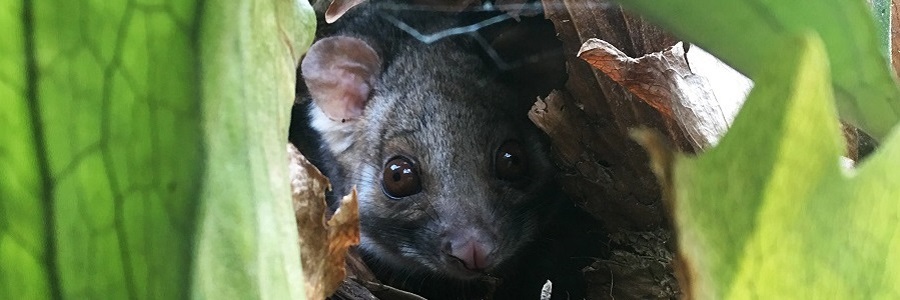Biological diversity

What is the occupancy and distribution of forest dependent fauna and flora species, and what are the predicted trajectories?
Community have expressed a strong demand on information about forest dependent animals and plants. NSW’s forests is home to many well-known species of nocturnal and diurnal birds, frogs, bats and arboreal mammals. Many threatened plants and vegetation communities are also found in these forests.
Project BD1: Baselines, drivers and trends for species occupancy and distribution
Project BD1: Baselines, drivers and trends for species occupancy and distribution
 |
 |
 |
 |
 |
 |
The Forest Monitoring Steering Committee commissioned a team of scientists from leading universities, NSW agencies and the private sector to develop baselines, drivers and trends for species occupancy and distribution forests across NSW Regional Forest Agreement regions.
The researchers have now delivered a final report.
Assessment outcome
This work is recognised as the largest and most significant project of this type in the history of NSW forest management. The report is a benchmark in terms of data collation, methodological approach and outcomes. The methods and datasets developed by the researchers provide a critical repository of knowledge, data and tools that advance knowledge of flora and fauna in NSW.
Researchers delivered a comprehensive suite of models to baseline species occupancy and distribution and help explore drivers in change. In summary, researchers delivered:
- nearly 450 fauna models, using data collected over 5,700 sites
- over 170 flora models, using data collected at nearly 5,250 sites.
This research delivers:
- new spatial datasets that can serve as baselines of future comparison for certain species and regions
- baseline information that identifies data gaps for many species
- tools to explore and identify changes to species occupancy from disturbances such as fire and invasive species.
Key findings
Researchers found a scarcity of large-scale, long-term monitoring programs since the early 1990s to establish reliable trends in species occupancy from data alone. Instead, species occupancy models provided the most useful metrics for reporting on the status and trends of fauna species, including measures of detectability and occupancy.
The researchers found that that the combined effects of climate change and fire represent the most significant threat to biodiversity in eastern NSW forests. Identifying appropriate fire regimes and mapping the shifting mosaic of fires across the forest estate to conserve biodiversity remains a major challenge. Climate projections suggest that potential occupancy of 54 of 78 threatened fauna species will decline by 2070, including the Powerful Owl and the Greater Glider.
Species exhibited a range of divergent responses with some more or less sensitive to changes in forest structure, climate, and other disturbance events. For example, between 1988 and 2011 in the forests south of Eden, the Powerful Owl and Sooty Owl recovered significantly after several major disturbances from a near-zero base in 1988 when monitoring surveys began. During the same period, the Greater Glider declined significantly and did not recover in the survey period. The results of the long term analysis is consistent with the literature that hollow dependent fauna species in particular are sensitive to timber harvesting.
Researchers also found that few plant species have been adversely impacted by native timber harvesting, although many species were recorded too infrequently for rigorous analysis. Nine rainforest and wet sclerophyll forest species were identified as likely to be sensitive to timber harvesting.
The researchers made a series of recommendations to improve monitoring with broader set of fauna survey methods, adoption of new technology, prioritisation of species most at risk of climate change and changing fire regimes, adequate resourcing and integration of monitoring programs.
The full findings and analysis are available in the final report. Project data and models are available on TERN Data Discovery Portal. Data can also be visualised and interacted with through the Spatial Collaboration Portal.
Papers and reports
- Final report - Baselines, drivers and trends for species occupancy and distribution (Kavanagh et al., April 2022)
Project BD2: Fauna monitoring on North Coast forests
Project BD2: Fauna monitoring on North Coast forests
 |
 |
A pilot study in 2021 assessed the feasibility of remote sampling techniques, detectability of various species and site establishment for the overall design of the monitoring program. This study was recently published and is available here.
From this, it was recommended that the program establish 300 monitoring sites across the Coastal IFOA estate to provide enough data and statistical power to estimate occupancy levels for a variety of species.
This project has been extended across Coastal IFOA state forests and continues under the Coastal IFOA Monitoring program, read more here.
Project BD3: Fauna call recognisers
Project BD3: Fauna call recognisers
 |
 |
 |
 |
In May-June 2020, the Forest Monitoring Steering Committee called for proposals from interested parties through a competitive grant process to develop call recognisers for a range of fauna species.
The Forest Science Unit at the NSW Department of Primary Industries were selected as the preferred provider, working closely with the Queensland University of Technology, NSW Forestry Corporation and AviaNZ.
This project has been continued under the Coastal IFOA program, more information on the project can be found here.
Project BD4: Koala and habitat response post-wildfires
Project BD4: Koala and habitat response post-wildfires
 |
 |
In August 2020, the NSW Forest Monitoring Steering Committee approved funding to investigate the impact of the 2019-20 wildfires on koalas and their habitat. This leveraged existing research in a cost-effective way and provides priority information for decision making and community.
Researchers from the Australian National University and the NSW Department of Primary Industries led the investigation. We produced a summary paper and a research note to outline their findings.
Researchers from the Department of Primary Industries published their findings in a peer reviewed journal and on the Department's website.
Researchers from the Australian National University provided a report on koala habitat response post-wildfires which is available as an addendum (page 35) to their report on harvesting impacts provided to us under the Koala Research Program.
The approach
The research used existing pre-fire data and analysis, including from our Koala Research Program and annual koala monitoring by Department of Primary Industries, combined with targeted sampling after the wildfires.
Knowledge gaps around the impacts of fire on koala density (site scale), koala occupancy (regional scale) and nutritional value of trees and sites for koalas were addressed.
Findings
In the summary paper, overall the researchers found:
- koala occupancy remained stable in north-east NSW after the 2019-20 wildfires (as measured across 50 sites)
- areas with a greater extent of medium or high fire severity experienced larger declines in koala density than areas with only low severity fire
- koalas were temporarily absent in some areas where high fire severity dominated the landscape but began to return after a year
- the epicormic post-fire growth of some tree species was found to have higher nutritional quality for koalas than mature leaves from the same trees pre-fire.
While koala populations at the research sites were relatively resilient following the 2019-20 wildfires, future fires may lead to more significant adverse effects as habitat quality, connectivity, and refuge areas may decrease and koalas may have less opportunity to recolonise between fire events.
The report examines a range of opportunities to improve outcomes for koalas following wildfires, for example reviewing koala browse species list to ensures species with high post-fire nutritional value are retained.
Papers and reports
- Research note - Koala and habitat response after 2019-20 wildfires (June 2023)
- Summary paper - Koala and habitat reponse after 2019-20 wildfires (November 2022)
- Koala and habitat response post-wildfires (See addendum on page 35 of this report)
